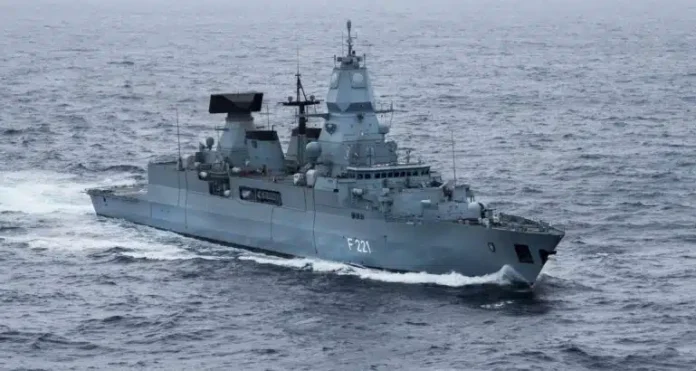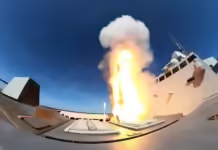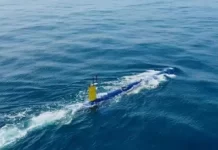
The Red Sea-deployment of German warship “Hessen” was off to a start with mixed results this week, as missile woes for the German Navy are clouding two successful drone-interceptions. The F124 Sachsen-class anti-air warfare frigate assigned to EUNAVFOR Aspides had arrived in the theatre of operations by February 26, Naval News reports.
One day later both the German Navy and US Central Command, the latter referring to a “coalition warship”, reported that Hessen had intercepted her first two hostile UAV, thought to be Houthi-controlled “one way attack drones”. According to media reports “Hessen” used her 76 mm-main gun and RAM missile system in the encounter.
All was not well however, as shortly after the initial news additional media reports revealed how Hessen had prior to this incident nearly shot down an American MQ-9 MALE UCAV (short for medium altitude long endurance combat drone).
The ship had detected the unidentified drone, which reportedly did not use its IFF(identification – friend/foe) and therefore considered it a possibly hostile contact. “Hessen” in response contacted liaison staff with the US-led mission Prosperity Guardian, who confirmed the drone was not theirs, approving an engagement. The frigate then launched two SM-2 missiles to intercept the target. Significantly however both missiles experienced a so far unspecified technical malfunction and fell into the sea. The failure is the second high profile incident involving SM-2 missiles on a German F124 frigate, following a misfire on “Sachsen” in 2018. After the identity of the MQ-9 became clear via means not detailed in media, the German warship broke off the engagement.
The SM-2 related missile woes contribute to questions looming for the German Navy regarding the status and reliability of their ammunition stockpiles sustaining highly dynamic and challenging deployments such as EUNAVFOR Aspides. In media reporting previously covered by Naval News a government response to a member of parliament suggested that the SM-2 Block IIIA missile has gone out of production. The report would imply that Germany may not be able to replenish any missiles expended beyond existing stockpiles. The government response in question remains unavailable for public access and neither the German Navy nor the Ministry of Defence have clarified said media report. Naval News has since attempted to obtain a more comprehensive picture on issues relating to missile supplies for the German Navy, notably for the SM-2 Block IIIA used by F124 frigates.
The most recent statement concerning awards for SM-2 production across several variants dates to December 2021. Manufacturer Raytheon then received an award worth $578 millionproducing 215 missiles for seven customers including the Netherlands and Denmark. In addition the US ordered 54 missiles. The variants covered by the contract include Block IIIA, IIIB and IIIAZ according to Raytheon. Notably the US government statement includes Germany, seemingly by mistake, as Berlin did not end up ordering any rounds.
The set date for completing deliveries is 2026. This suggests the aforementioned claims on production having ceased are incorrect. However, related confusion may arise over terminology. The precise issue more likely is that the required lead time for follow-on orders for Block IIIA-type missiles has expired. When contacted by Naval News, Raytheon would not comment on their ability to fill further orders, referring to the US Navy. A relevant industry source familiar with the program also asked by Naval News has cast doubt on the feasibility of follow-on orders. Raytheon does intend to produce further SM-2 Block IIIC until at least 2035. The US Navy will remain a significant user for this version, among other customers. The American Zumwalt-class destroyers require the Block IIIAZ-variant due to their bespoke AN/SPY-3 X-band radar. Seeing how adaption for another SM-type missile is not currently planned, the Block IIIAZ-variant will likely remain in production.
European APAR-radar facing obsolescence-challenges

This leaves the Block IIIA-variant, which is required by users of the European APAR active phased array-radar. These include Germany, the Netherlands and Denmark on their F124, LCF- and Iver Huitfeldt-class frigates respectively. APAR is an X-band-radar and requires a respective downlink guiding SM-2. APAR in this context is different to AN/SPY-series radars used with the AEGIS-combat system, which make use of the S-band. The X-band downlink for APAR is also different to the solution used for Zumwalt. The AN/SPY-3 used on these destroyers performs SM-2 guidance via its Joint Universal Weapon Link (JUWL). From 2028 the Netherlands intend to upgrade at least two of their four LCF-frigates to the APAR Block 2-configuration. This includes JUWL-support, and therefore a notional capability also for SM-2 Block IIIAZ.
Germany currently has no intention modernizing APAR beyond the already scheduled upgrade for F124. The German Navy therefore faces an obsolescence-dilemma for their SM-2 supply, as does Denmark. While longer term-solutions including JUWL-adaption similar to the Dutch effort remain possible, this will not resolve Berlin’s immediate stockpile woes. According to SIPRIGermany originally ordered 108 SM-2 Block IIIA missiles between 2003 and 2005. Berlin does not appear to have made any follow-on purchases since then. Accounting for missiles expended in exercises Naval News estimates around 70 SM-2 from the original order remain available. Such an amount is sufficient for one combat load for each of the three F124 frigates. This estimate is based on 24 interceptors carried in addition to 32 ESSM quad-packed into the remaining cells.
More questions over German ESSM stockpile

The supply of ESSM medium range missiles is a further point of concern for the Hessen and her sisterships. Germany originally ordered 175 missiles of the Block I-variant to be used by F124. In 2023 Berlin placed a new order for the Block II-variant, but only for an “initial capability”. Numbers on the purchases were not divulged, but they appear to be limited. When announcing the 2023-order, Berlin also stated that a second batch fully equipping F124-frigates was to follow in 2024. Notably the German Navy also intends to use older Block 1-missiles with their F123-frigates. These four ships have started to undergo a significant modernization including ESSM-integration.

The only air defence missile type for which a certain supply appears to exist is the RIM-116 Rolling Airframe Missile. Germany in 2022 ordered 600 RAM Block 2B, adding to previous orders for the Block 1A and Block 2-variants. RAM however remains a self defence-capability with an estimated range of only up to 13 km.
In summary it appears that Germany is currently facing a significant capability dilemma for a key weapon system. This outcome is a consequence of delayed modernization efforts, insufficient restocking of ammunition and unanticipated operational commitments. The missile woes for the German Navy add further questions over the substance of the “Zeitenwende”. German Chancellor Scholz declared this “Turning Point” in February 2022. However, two years on a well supplied German military has yet to emerge.
UPDATE 2/03/24
The German Ministry of Defence has since released a statement clarifying the MQ-9 intercept attempt. It confirms the details already reported here on Naval News. The information provided also clarifies that the malfunction experienced by Hessen relates to guidance of the missiles by the frigate. A technical defect of the SM-2 interceptors themselves can therefore be ruled out. As APAR provides midcourse-guidance and terminal illumination, the statement suggests a related defect. The German MoD emphasizes the fault was identified quickly and has no further impact on the operational readiness of “Hessen”.



